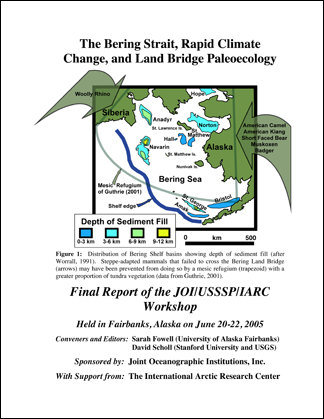The Bering Strait, Rapid Climate Change and Land Bridge Paleoecology
June 20-22, 2005 – Fairbanks, Alaska
Convener: David Scholl, Sarah Fowell

Summary
Coring intercalated terrestrial and marine sediment preserved in Bering Sea basins will, for the first time, permit direct dating of the opening and closing of the Bering Strait and clarify its role in the onset and termination of northern hemisphere glaciations. Whereas the presence of terrestrial sediment, including coal and paleosols, has been well documented in the Cretaceous-Eocene sections of Bering Sea basinal sequences, the origin of Plio-Pleistocene units remains uncertain. Workshop participants agree that additional processing of existing seismic data is needed in order to extract further information regarding the nature and thickness of sedimentary units and select optimal coring sites.Identification of terrestrial and marine deposits in cores will be based on micropaleontology, sedimentology, C/N ratios, and beryllium isotopes. Units will be dated by multiple methods with overlapping temporal ranges. Experimental methods, including TL, OSL, and cosmogenic isotopes can be employed to provide additional estimates of the dates of land bridge emergence and burial. Correlations will be based on sedimentology, chemostratigraphy, and marker beds such as ash deposits and paleosols. Radiometric dating of tephra units will facilitate correlation of terrestrial and marine records throughout Beringia and explore connections between explosive volcanism and rapid climate change.Reconstruction of in Bering Sea productivity, water mass circulation, depth, SST, and sea-ice cover based on sedimentary, isotopic, and biological proxies will clarify the impact of changes in global ocean circulation caused by opening and closing of the Bering Strait gateway. This dataset has the potential to resolve decades of debate regarding the nature and significance of the gateway with respect to abrupt and gradual climate changes. Analyses of insects, pollen, grass cuticle, phytoliths, and stable isotopes from terrestrial deposits will provide the first paleoclimatic and paleoecological reconstructions of the submerged Bering Land Bridge. With these data, we can finally address longstanding questions regarding human habitability, biogeography, and the relationship between land bridge emergence, competition, and faunal extinctions.
Workshop Report (pdf)
Organizing Committee
Sarah Fowell, University of Alaska Fairbanks
David Scholl, Stanford University and US Geological Society






